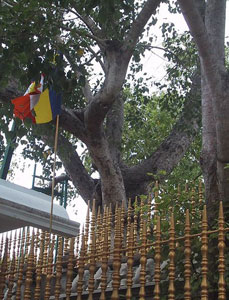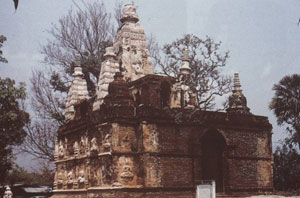According to the Mahavamsa, the right branch of the Bodhi tree under which the Buddha attained Enlightenment was brought to Sri Lanka by Theri Sanghamitta in 288 B.C., the eighteenth year of King Asoka’s reign. King Devanampiyatissa received the sacred sapling with great veneration and planted it in the Mahâmeghavana in Anuradhapura. In time, the Bodhi tree became a symbol of political power for the Sinhalese Kings until the arrival of the Sacred Tooth Relic of the Buddha in the 4th century.
There are unbroken records of Royal patronage given to protect the Bodhi tree in Anuradhapura. There are many books both in Pali and Sinhalese literature written on the history of the Bodhi Tree in Sri Lanka. The Bodhi tree at Anuradhapura is the oldest documented tree in the world.
 |
| One of the most venerated Buddhist sites in Sri Lanka, the Sri Maha Bodhi tree in Anuradhapura |
The original tree at Buddhagaya was destroyed in the 34th year of King Asoka’s reign, about 15 years after Theri Sangamitta brought the southern branch of the Bodhi tree to Sri Lanka. This was done by the young Queen Tisyaraksita who was jealous of the great attention shown by the King towards the tree. Asoka was most distressed about the destruction of the tree and when the tree grew again, Asoka surrounded it with a stone wall ten feet high.
Another destruction of the Bodhi tree is recorded by Hiun Tsang, the 7th century Chinese pilgrim to Buddhagaya. He reported seeing the remains of the walls around the Bodhi tree that were constructed by Asoka. Sasanka, an enemy of Buddhism cut down the Bodhi tree, digging up to the very springs of the earth, but did not get to the bottom of the roots. Then he burnt it down. Some months later, Purnavarma, the last of the lineage of Asoka, bathed the tree with cow milk after which it grew again. Hiun Tsang gives details of the Mahabodhi monastery, a university complex like Nalanda and Wikramashila which were funded by the Sinhalese from the 4th to 14th century.
After the Muslim invasions in the 11th century, there was devastation of all Buddhist sites in India. The Bodhi tree site continued to be neglected until the Burmese King in the 14th century arranged for the repairs and restoration of the Buddhagaya Temple and environs.
This was done once again in the early 19th century. It was the Director General of Archaeological Survey of India, Sir John Marshall in 1905 who completed the excavation work begun by Sir Alexander Cunningham that the site of the Bodhi tree was located with the assistance of the records of the Chinese traveller Fa Hsien of the 5th century. Sir Marshall obtained a Bo-sapling from the Sri Maha Bodhi tree at Anuradhapura and planted it at the same site of the original tree at Buddhagaya.
Bodhi Trees in South East Asia
After the Sangha reforms by Parakramabahu I in 1165, Sinhala Bhikkhus made a far reaching impact on South East Asia which continued with great vigour through the centuries. Sinhala Bhikkhus took along with them Buddha relics, replicas of Buddha’s Footprint and shoots of the sacred Bodhi tree. Most of the Bodhi trees planted subsequently in South East Asia stem from the Bodhi tree in Anuradhapura. By the 12th century, the Sinhala Sangha sect had been established in Myanmar and its impact was spreading in the region.
Bodhi trees in Thailand
During the reign of King Luthai begun in 1347, the Sinhala Sangha was established in Sukhothai, the first kingdom of Thailand. A Thai inscription of 1357 mentions the arrival of a Buddha relic and a branch of the sacred Bo tree from Sri Lanka. Two Thai inscriptions dated 1359 describe the welcome accorded by King Luthai to the Sinhalese Mahasami Sangharaja [Medhankara] and the King receiving temporary ordination from him.
The next reference to a Bodhi tree from Anuradhpura appears during the reign of King Tilokaraja (1441-87) of Ayutthia. According to the Jinakalamali, the King had planted in 1455, at a monastery in Chiangmai, a seedling, brought from the sacred Bodhi tree at Anuradhapura. The monastery was now named Mahabodhi Arama (Wat Cet Yod in Thai). The King of Sri Lanka during this time was Parakramabahu VI (1412-1467) of Kotte.
It has also been recorded that this king had a General named Sihalagotta (Sinhala clan). General Sihalagotta had rebuilt the shrine called Rajakuta in Chiangmai, and deposited a sacred relic, brought from Sri Lanka.
Laos
King Jayavarman Paramesvara of Cambodia (1327) had given his daughter in marriage to the ruler of Laos, and in response to a request made by the daughter to introduce Buddhism into that country, he sent three of his Sinhalese Bhikkhu advisors there.
 |
| 14th Century Bodhi tree in Thailand |
The delegation took along with them a gold Buddha image called Prabang that had been gifted to Cambodia in 1056 CE by the Sinhalese king Vijayabahu I (1055-1110 AD). The new capital city of Laos was named Luang Prabhang after this image.
The delegation had also taken a sapling from the sacred Bo tree in Anuradhapura and according to the Sinhalese tradition, this was ceremoniously planted in the new capital.
A Buddhist temple (wat) which came to be called Wat Po Lanka (the temple of the Sri Lanka Bo tree) was constructed near the Bo tree, together with a sacred cheti (chaitya) enshrined with a Buddha relic and quarters for the monks.
Myanmar
I have not found any inscriptional or textual evidence in Myanmar to indicate that Bo saplings from Sri Lanka were taken to Myanmar in the early centuries. It appears that the worship of the Bodhi tree had become a Buddhist ritual since the late 19th century. Bodhi trees are now found in many of the monastic complexes in Myanmar. Only in the last several decades, did pouring water on the Bodhi tree, called Kason become an important part of the religious ceremonies conducted on Vesak day. The Kason-water pouring ceremony is usually preceded by a grand pageantry where people, mostly women carry pots of perfumed water and flowers, and chant Pali gathas. Finally, water is poured at the foot of the Bodhi tree. At night, it turns into a festival of music and dance, usually held at the temple.
Cambodia
After King Poòhea Yat of the 15th century established Phnom Penh as the capital, according to Cambodian chronicles, he built there five key wats (vihara) which were all associated with Sri Lankan monks.. They were Wat Boddhaghosachar, Wat Unnalom (present residence of the Sangharaja of Maha Nikaya), Wat Koh, Wat Dhammalankara and Wat Lanka. Although there is mention of a golden Buddha statue brought from Sri Lanka, no mention is made of a Bodhi sapling. A full grown Bodhi tree, however, is still to be seen at the site identified as that of Wat Koh which is no more.
Another Bodhi tree found today in Cambodia is a tree grown from a sapling taken from Sri Lanka in the 19th century and located in the monastic complex of the Sangharaja of Dhammayut Nikaya.
Hawaii
There is a Bodhi tree planted in 1903 in the Foster Botanical Garden in Hawaii. It came to be planted there as a result of the long contact Mary Mikahala Foster of Hawaii had with Anagarika Dharmapala. She became Dharmapala’s benefactress ever since she met him on his stopover at Honolulu on his way to Japan from the Parliament of World Religions in Chicago in 1893. The monks who met Mary Foster when she visited Anuradhapura had sent in 1913 as a gift for her, a cutting from the Bo-Tree through Dharmapala on his visit to Honolulu.
The Bodhi tree is not only a symbol of the Buddhahood, but also an emissary of Sinhalese cultural interests.
(The writer is a member of the 2600 Sambuddhattva Jayanthi Presidential Steering Committee) |



